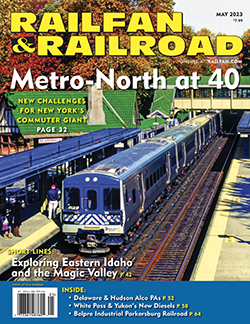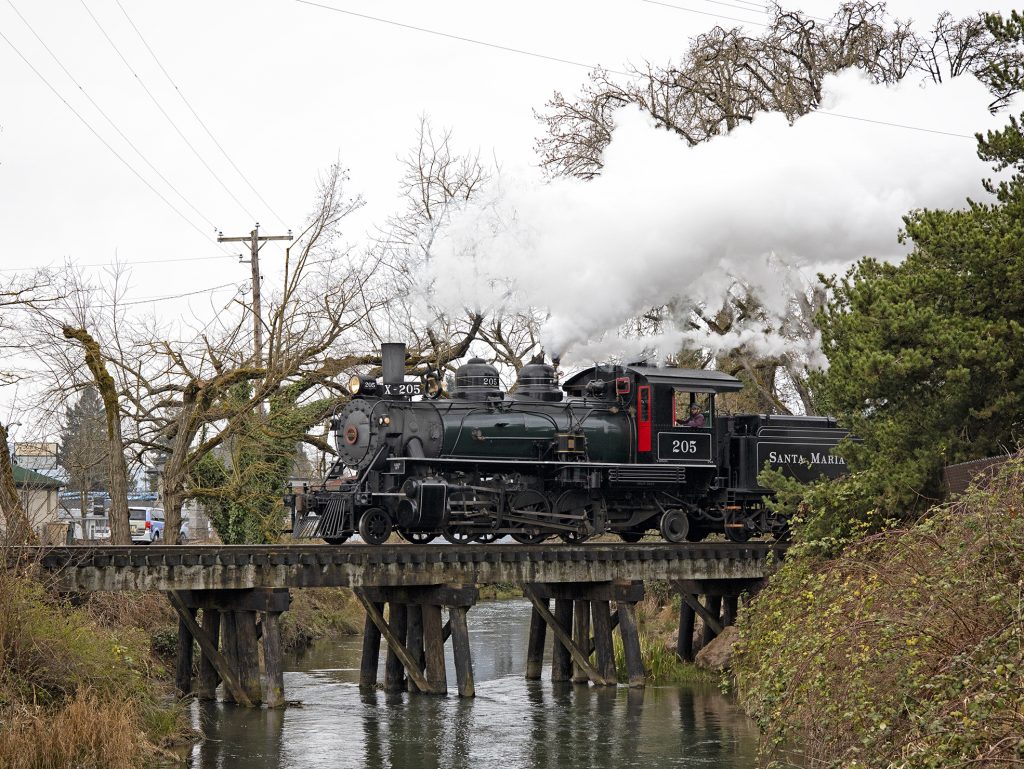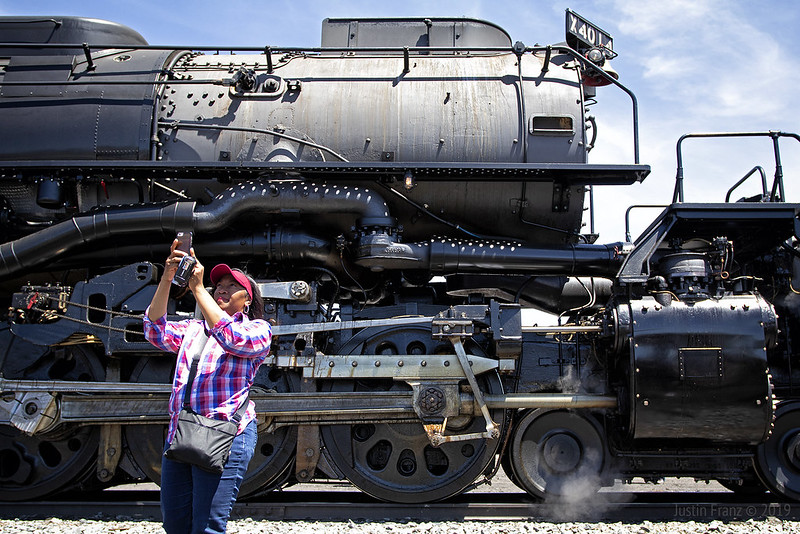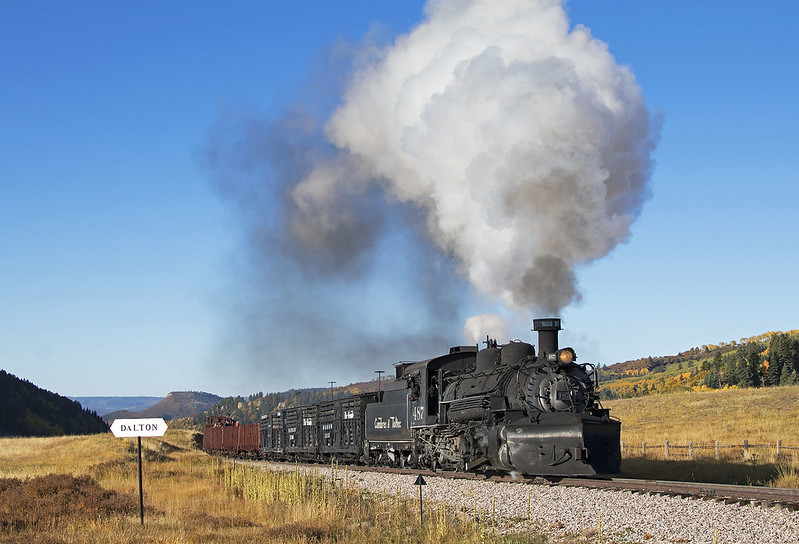 By Justin Franz/photos by the author
By Justin Franz/photos by the author
I was recently looking at some steam-era photos in the Center for Railroad Photography & Art (railphoto-art.org) collection that got me excited about the prospect of shooting steam this year. In turn, that got me thinking about the different tactics I’ve employed when photographing steam. I’m sure like many of you, the vast majority of my time trackside is spent photographing locomotives of the internal combustion variety. And while steam locomotives often run on those very same rails, I’ve found that photographing them requires a slightly different approach. Here are a few things I’ve considered over the years when trying to capture images evocative of the steam era.
Lens up, rods down
As I said, I don’t get to shoot steam as often as I would like — maybe once or twice a year if I’m lucky. As a result, I almost always find myself quickly adjusting my composition for that first shot after a long steam drought because I invariably forget about the massive plume of smoke and steam that locomotives usually produce. That plume is part of the reason why steam locomotives are so spectacular to look at, and if you study some of the very best steam-era shooters (Phil Hastings, Donald Furler, Lucius Beebe, and the like), you’ll find that they almost always composed for that. If you look at their images and imagine that the smoke plume was gone, you’re most likely going to find that the images are just a little bottom-heavy.
With your lens up, try to remember to get those rods down. A classic trope of steam-era photography was having the connecting rods of the locomotive in the “down” position. Besides just being more visually pleasing, this provides the clearest view of all of the workings of the side rods and driving wheels. I’m unsure if the abovementioned steam-era masters were good enough at picking the exact moment to expose the frame to ensure the rods were down, but I do know if they did get a well-lit and well-composed negative with the rods down, they most definitely made a print. This is one area where those of us working in the digital age have a big advantage. With digital cameras that can shoot upward of a dozen frames per second, it can be pretty easy to pick out that perfect rods-down image in post-processing. (As an aside, I almost always shoot at the highest frame-per-second rate that I can. This is mostly a holdover from working at a newspaper where I took a lot of photos of people and wanted to make sure I never got someone blinking. It’s probably a habit my hard drive wishes I would give up…)
 Santa Maria Valley 2-6-2 205 crosses a wooden trestle in Lebanon, Ore., on March 19, on Albany & Eastern. By selecting this tight location, the photographer was able to hide the more modern-looking passenger train that followed the locomotive. —Photo by Justin Franz.
Santa Maria Valley 2-6-2 205 crosses a wooden trestle in Lebanon, Ore., on March 19, on Albany & Eastern. By selecting this tight location, the photographer was able to hide the more modern-looking passenger train that followed the locomotive. —Photo by Justin Franz.
Leave the telephoto at home
I have taken plenty of photos of steam with telephoto lenses, but in my opinion, a steam photo taken with a “normal lens” (usually a 50mm or thereabout) almost always looks better. I think that is especially true if you’re trying to capture an image evocative of the steam era, at which point, I actually recommend you leave the digital cameras at home and buy some film. (Seriously, try it. It really does work.)
One reason I think the normal lens shot works better with steam versus a “tele-smash” is that you have a better chance of capturing that smoke plume we discussed a few moments ago. But it’s also because of a simple fact of steam-era photography — few people had teles because they weren’t widely available until the 1960s or so. In fact, when John Gruber first used a telephoto lens for railroad photography — the results of which ended up on the cover of Trains magazine — it was met with a strong reaction from some readers who hated the effect. Thankfully, readers quickly got used to and embraced the telephoto.
The same could be said about drones and steam. If a tele-compressed photo isn’t going to evoke the steam era, I think it’s safe to say that one taken some 100 feet up in the air isn’t going to do it either. Granted, one of the first photos that convinced me to buy a drone was an overhead photo of a narrow gauge German steam train twisting and turning through the Harz Mountains, so I guess there’s an exception to every rule (more on those exceptions later).
Looking for atmosphere
Equally enticing as the steam locomotive itself are the tools, people, and locations that often come with them. Steam railroading is dripping with ambiance. Need proof? Why not head to Ely, Nev., home to Nevada Northern Railway, or Chama, N.M., the western terminus of the famous Cumbres & Toltec Scenic, and you’ll see what I mean. Steam locomotives were and are labor intensive and as such, need large facilities to be maintained. Where those facilities survive there are endless photo opportunities to be found.
Over the years, I’ve attended a few of Nevada Northern’s annual winter photography weekends. While posed photos of workers polishing headlights or oiling various components have become a hallmark of such events in recent years, I always avoid those staged scenes in favor of the authentic ones that occur naturally throughout the day. If you can get access to the location where a locomotive is being readied, get there as early as possible, introduce yourself to the crew (they’re bound to act a little more natural if you’ve had a conversation already), and then wait for the photo-worthy moments to present themselves. No staging is needed.
Out along the line, look for buildings and bridges evocative of another era. Also, if you’re shooting an excursion train, find ways to “hide” the cars behind the locomotive, especially if it’s a freight-hauling steamer. Case in point: Recently, I was in Lebanon, Ore., photographing Albany & Eastern’s new Santiam Excursion Train behind Santa Maria Valley 205, a petite 2-6-2 built by Baldwin in 1924. Behind the locomotive were a few smooth-side passenger cars that would look more appropriate behind an E-unit than a Prairie, as well as a converted gondola. Thankfully, the gondola was directly behind the locomotive, making it easier to hide those more modern passenger cars when photographing the train head-on or from the side, as I did at a short trestle in the middle of town.
Another great opportunity to photograph steam with a more authentic consist is the “Engineer for an Hour” event. On some railroads (like Cumbres & Toltec), they’ll usually put the locomotive on a short string of boxcars and head out on the line. Or they’ll just have a caboose behind the locomotive, looking like a hack hop from yesteryear.
One other thing: Whenever you visit a tourist railroad or museum, be sure to support it with a donation or by dropping a few bucks in the gift shop (or buy a souvenir ticket). Every little bit helps and it’s important to remember that a lot of time, energy, and money goes into running the steam-powered spectacles we all enjoy.
 Steam locomotives in the 21st century attract big crowds, so don’t forget to incorporate them into your photos, such as at Evanston, Wyo., in May 2019. —Photo by Justin Franz
Steam locomotives in the 21st century attract big crowds, so don’t forget to incorporate them into your photos, such as at Evanston, Wyo., in May 2019. —Photo by Justin Franz
Embrace the chaos and forget the rules: The above thoughts and “rules” are ways that I’ve come to approach photographing steam whenever I try to create images evocative of another era. But sometimes it’s important to throw out the rules altogether and embrace what is in front of you. In the October 1992 Camera Bag column, former editor Jim Boyd wrote, “There is a lot about steam in the 1990s that is tasteless, garish, disappointing, phony, and even downright boring.” I can assume some of what he was talking about were hokey balloon stacks, mismatched passenger cars, and corny headlights, although one can argue that some of the worst offenses came decades earlier in the 1960s and 1970s. Regardless, the steam scene in the 2020s is considerably different and it seems most operators are interested in embracing historical accuracy. But even when the consist is mismatched and it’s clear what you’re shooting is a steam-powered tourist train in the 21st century, don’t try to hide it in every photo. In some ways, the balloon stacks of yesterday are becoming “vintage” in their own right. One only has to look at Durango & Silverton Narrow Gauge, which just last year put a diamond stack back on one of its K-28s in a throwback to the Rio Grande tourist era of the ’60s and ’70s.
“Embracing the chaos” for main line steam is also a good rule of thumb. Try as hard as you might, I can almost guarantee that you’re not going to get a photo of Union Pacific 4-8-8-4 Big Boy 4014 that is going to trick someone into thinking you went back in time to the 1940s and 1950s; the diesel helper, the bright yellow auxiliary tenders, the passenger train, and the hordes of people who follow the country’s most famous steam locomotive will make sure of that. So embrace it. Include photos of the huge crowds swarming the locomotive, of people snapping selfies, and of the traffic jam that is inevitably following it. Those images are illustrative of the steam era in the 2020s, just as the image of a denim-clad and pipe-smoking engineer oiling their locomotive is of the 1920s.
At the end of the day, whether you’re shooting an authentic photo freight on East Broad Top or the chaos of a Big Boy tour, shooting steam is fun!


